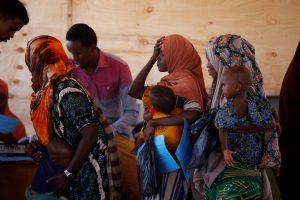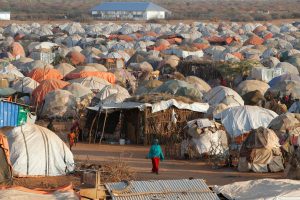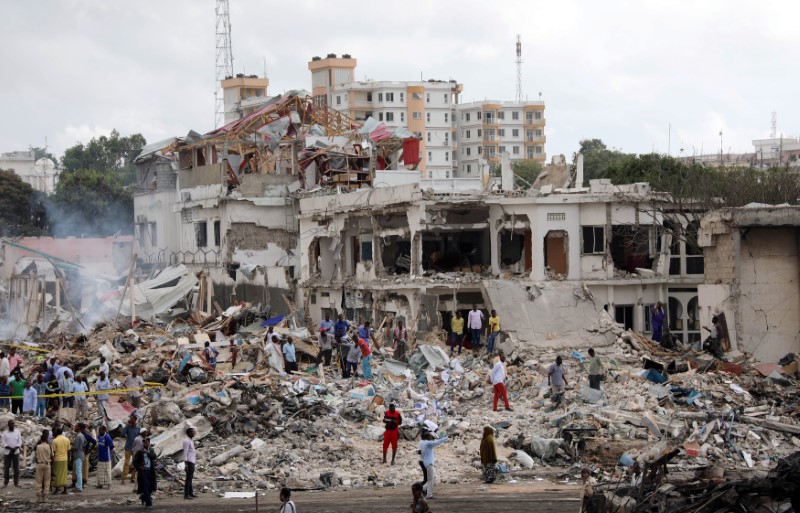
By Katharine Houreld
NAIROBI (Reuters) – The United States is suspending food and fuel aid for most of Somalia’s armed forces over corruption concerns, a blow to the military as African peacekeepers start to withdraw this month.
African Union (AU) troops landed in Mogadishu a decade ago to fight al Shabaab Islamist militants and Somali forces are supposed to eventually take over their duties.
But the United States, which also funds the 22,000-strong peacekeeping force, has grown frustrated that successive governments have failed to build a viable national army.
Diplomats worry that without strong Somali forces, al Shabaab could be reinvigorated, destabilize the region and offer a safe haven to other al Qaeda-linked militants or Islamic State fighters.
The U.S. suspension of aid came after the Somali military repeatedly failed to account for food and fuel, according to private correspondence between the U.S. and Somali governments seen by Reuters.
“During recent discussions between the United States and the Federal Government of Somalia, both sides agreed that the Somali National Army had failed to meet the standards for accountability for U.S. assistance,” a State Department official told Reuters last week, on condition of anonymity.
“We are adjusting U.S. assistance to SNA units, with the exception of units receiving some form of mentorship, to ensure that U.S. assistance is being used effectively and for its intended purpose,” the official said.
The U.S. suspension comes at a sensitive time. The AU force – with troops from Burundi, Djibouti, Ethiopia, Kenya and Uganda – is scheduled to leave by 2020. The first 1,000 soldiers will go by the end of 2017.
The State Department official said Washington would continue to support small, Somali special forces units mentored by U.S. personnel and would work with the Somali government to agree criteria that could restore support to other units.
“It is true that some concerns have been raised on how support was utilized and distributed. The federal government is working to address these,” Somali Minister of Defence Mohamed Mursal told Reuters.
WHERE’S THE AID?
Documents sent from the U.S. Mission to Somalia to the Somali government show U.S. officials are increasingly frustrated that the military is unable to account for its aid.
The documents paint a stark picture of a military hollowed out by corruption, unable to feed, pay or arm its soldiers – despite hundreds of millions of dollars of support.
Between May and June, a team of U.S. and Somali officials visited nine army bases to assess whether the men were receiving food the United States provides for 5,000 soldiers.
“We did not find the expected large quantities of food at any location … there was no evidence of consumption (except at two bases),” the U.S. team wrote to the Somali government.
At one base, less than a fifth of the soldiers listed by Somali commanders were present. The best-staffed base had 160 soldiers out of 550. Only 60 had weapons.
“Many appeared to be wearing brand new uniforms. This implied they were assembled merely to improve appearances,” the letter, seen by Reuters, said.
An ongoing assessment of the Somali military this year by the Somali government, African Union and United Nations drew similar conclusions.
The joint report seen by Reuters said many soldiers lacked guns, uniforms, food, vehicles or tents. Troops relied on support from AU forces or local militias to survive.
“The SNA is a fragile force with extremely weak command and control,” the report said. “They are incapable of conducting effective operations or sustaining themselves.”
Most units don’t have radios, leaving soldiers to rely on runners to get help when mobile networks go down, the report said. Troops lacked paper to write reports, toilets, boots and medical equipment such as tourniquets. Many slept under trees.
SNA units were at 62 percent of their authorized strength on average. Only 70 percent of them had weapons, the report said.
Although the report was deeply critical, diplomats praised the government for trying to quantify the scope of the problem.
“The government deserves massive praise for doing it and being willing to talk about it,” Michael Keating, the U.N.’s top official in Somalia, told Reuters.
CASH PAYMENTS SUSPENDED
The United States also suspended a program paying soldiers $100 monthly stipends in June after the federal government refused to share responsibility for receiving the payments with regional forces fighting al Shabaab.
Washington has spent $66 million on stipends over the past seven years but has halted the program several times, concerned the money was not going to frontline soldiers.
One Somali document seen by Reuters showed members of a 259-strong ceremonial brass band were receiving stipends this year meant for soldiers fighting militants.
The State Department’s watchdog said in a report published in October there were insufficient checks on the program and U.S. stipends could fund forces that commit abuses – or even support insurgents.
Officially, Somalia’s military is 26,000 strong, but the payroll is stuffed with ghost soldiers, pensioners and the dead, whose families may be receiving their payments, diplomats say.
Intermittent payments from the government have forced many active soldiers to sell their weapons, ammunition or seek other work – practices the U.S. stipends were designed to curb.
Washington has whittled down the number of troops it pays to 8,000 from over 10,000 but there is still no reliable payroll, said a Mogadishu-based security expert.
Defence Minister Mursal said the United Nations is creating a biometric database and plans to help the Somali government make cash payments directly to soldiers via mobile phones.
The new government will also set up a separate system for widows, orphans, and the wounded so the payroll would adequately represent military strength, he said.
UNDER ATTACK
The weakness of Somali forces has deadly consequences. The insurgency is striking with ever larger and more deadly attacks in the capital Mogadishu and major towns.
A truck bomb killed more than 500 people in October and a suicide bomber killed at least 18 at a police academy on Thursday.
Yusuf, a 35-year-old Somali soldier stationed near the Indian Ocean port of Kismayu, knows what it’s like to depend on local militias and AU forces to stay alive.
On Sept. 26, insurgents attacked his base at Bula Gadud, killing 15 colleagues and wounding scores more before the local Jubaland militia and AU peacekeepers saved them.
“We lost several key members in that battle especially my close friend,” he told Reuters. “We tried to retreat … after using all the ammunition we had.”
A senior Somali security source said when the attack happened, the battalion of more than 1,000 soldiers had only been issued 300 guns.
Defence Minister Mursal said the Somali troops at Bulagadud have since been sent more weapons.
Somalia’s national security plan calls for a military of 18,000 soldiers, funded by the central government and operating country-wide.
Getting there will be hard. Security experts say the military is dominated by a powerful clan, the Hawiye, which would be reluctant to lose control of the lucrative security assistance revenue stream.
Many regional governments within Somalia already see the Hawiye-dominated federal forces as rivals rather than allies.
The government’s ability to push reforms depends on balancing demands from federal member states, lawmakers, clan leaders and international partners, the U.N.’s Keating said.
“It’s going to take a long time and its going to run into massive clan resistance,” he said. “Some clans are very dominant in the security forces.”
Somalia’s partners also need to get serious and coordinate better, said Matt Bryden of the think-tank Sahan Research.
According to Sahan, donors – including the EU, AU, Turkey and Uganda – have trained more than 80,000 Somali soldiers since 2004. Bryden said records are so poor it was not clear if many had taken multiple courses, or just quit afterwards.
“It’s like sand through your fingers – where are they all?”
(Additional reporting by Phillip Stewart in Washington D.C. and Khadar Hared in Nairobi; editing by David Clarke)












